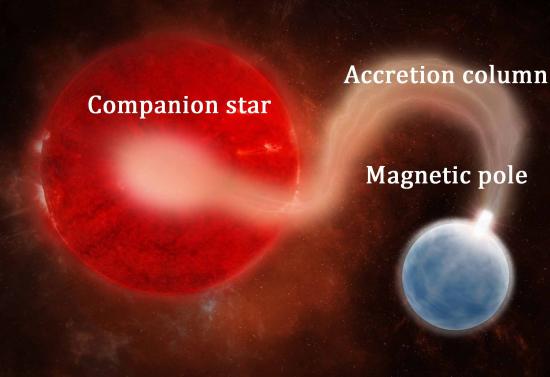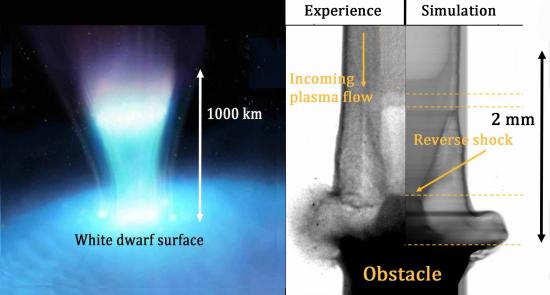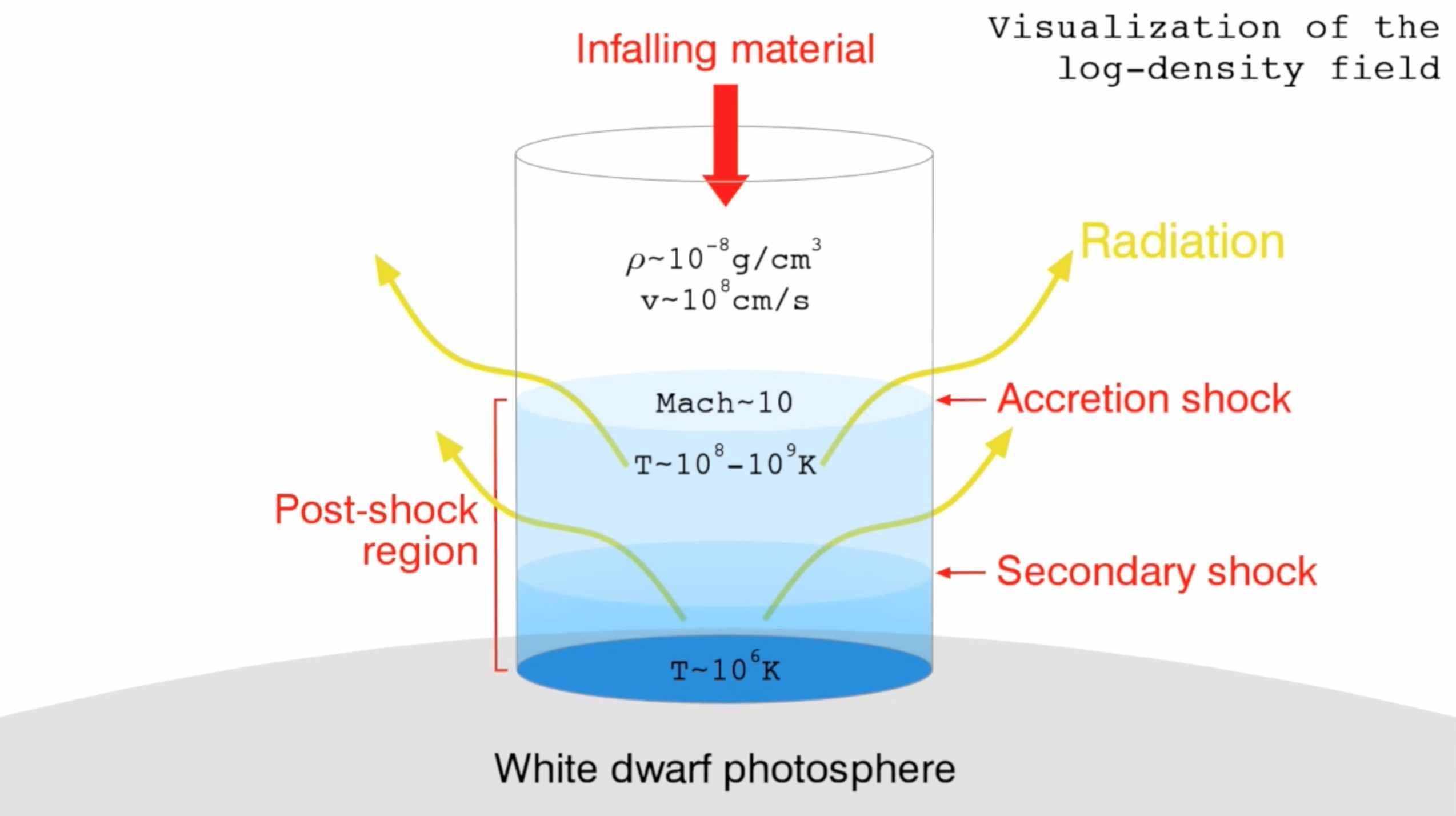Scientists from a large international collaboration (Oxford, AWE, CEA, LULI, Observatoire de Paris, University of Michigan, University of York and STFC Rutherford Appleton Laboratory) have succeeded for the first time in generating a laboratory analogue of a strong shock that is produced when matter falls at very high speed on the surface of extremely dense stars called white dwarfs. Understanding the physics of these astrophysical objects is crucial because they are considered as the possible progenitors of thermonuclear supernovae. These supernovae are used in cosmology to measure the acceleration of the universe expansion that is linked to dark energy. To perform this spectacular astrophysics experiment, the scientists made use of the powerful Orion Laser Facility at Aldermaston (UK) to evaporate a millimetre size target and produce a hot plasma flow for an extremely short duration (less than 100 nanoseconds) [1].
Recent theoretical work has shown that, by using adapted scaling laws, this tiny size experiment can be scaled to its cosmic counterpart making it a valid replicate. Powerful lasers can therefore be used as microscopes to explore, during few nanoseconds, the high-energy radiation processes occurring in astrophysical objects from regions largely unresolved by the most powerful telescopes. The Orion experiment which is the first academic experiment on this facility, confirms that these accretion shocks, which could not be studied in laboratory a few years ago at exact scale, can now be produced commonly in laboratory. These results are published in Nature Communications, June 13th, 2016.
The Orion experiment [2] was set up to replicate the processes taking place in stellar binary systems containing a highly magnetized white dwarf that captures matter from a small mass secondary star. These systems called magnetic Cataclysmic Variables (mCVs) provide a unique insight to study accretion processes in extreme astrophysical regimes. Because of the very high (B > 10MG) magnetic field, matter captures by the white dwarf is channelled in a very narrow region above the white dwarf magnetic pole, called an accretion column with dimensions typically from 100 to 1000 kilometres. Radiation collected from these objects mainly comes from this unresolved area near the white dwarf surface and is produced below an accretion shock. Understanding the physics of this radiation hydrodynamic region is primordial since it is the key to infer of the white dwarf properties and the initial conditions of supernovae explosion.

Artist's vision of a magnetic cataclysmic variable. In these systems, a "white dwarf" an extremely dense star, gravitationally sucks the material of a nearby companion star in an "accretion" column. This accreted material produces a high-energy radiation when it reaches the surface of the dense star at the magnetic pole. Copyright Animea/F. Durillon
Using specific scaling laws coupling radiation and hydrodynamic, the scientists were able to determine that to achieve an equivalent in the lab of an accretion column, all parameters have only to be shifted by the right amount in the space-time domain. What happens in a 1000 km accretion column in about one second would be equivalent to what takes place at millimetre size during a few nanoseconds, providing that enough energy is injected by a laser.
In the actual experiment, a 2 kiloJoule laser shot of 1 nanosecond duration was focused onto a 600-micrometre diameter target used to drive a hot plasma at a 200 km/s velocity. Instead of a magnetic field, the plasma was collimated by a plastic tube 3.mm long, ended by a steel obstacle. The laser-produced plasma, tube and obstacle formed the laboratory analogues of the incoming flow, magnetic field collimation and white dwarf surface, respectively, in the astrophysical case.
The main difficulty the scientists had to face was actually to see and record what happens in such a short time. To do this, they had to use another very short laser pulse (500 picoseconds) able to generate an X-ray source that probe the plasma in the tube. By measuring the varying transmission by the plasma, the density can then be reconstructed by this ultrafast X-ray radiography. With this complex experiment set-up, a time-sequenced image was produced showing clearly the building of the shock, analogous to the structure predicted by astrophysical models and numerical simulations.

Leftt: Artist's Vision of the white dwarf magnetic pole . The star is surmounted by an accretion column with height of about 1000 km, in which the material (plasma) strikes the surface of the star
Right: In the laboratory experiment, the plasma produced by the laser is channeled through a tube with a length of a few millimeters. It crashes into a steel barrier producing a shock that builds an accretion column. The left side represents the X-ray radiography of the hot gas, the right side the computer numerical simulation. Copyright : J. Cross / Oxford Univ.
It is the very first time that an accretion shock is directly observed with X- ray radiography in such regimes. The physical properties of the radiative post-shocked region were probed while this structure cannot be observed at the astrophysical scale with telescopes available today. Though strong limitations still exist; the Orion experiment confirms that these complex radiation hydrodynamic flows, which could not be studied in laboratory a few years ago, can now be produced commonly in laboratory. These experiments were first initiated at the LULI200 facility (Laboratoire pour l’Utilisation des Lasers Intenses). The next step is to adapt the target design to the more powerful Megajoule lasers (NIF and LMJ) [3] which provides the laser energy needed to produce a radiative regime similar to the accretion columns of the magnetic cataclysmic variables.
Contacts : J.M. Bonnet-Bidaud,
Publications :
Publication
“Laboratory analogue of a supersonic accretion column in a binary star system”
J. E. Cross, G. Gregori, J. M. Foster, P. Graham, J. -M. Bonnet-Bidaud, C. Busschaert, N. Charpentier, C. N. Danson, H. W. Doyle, R. P. Drake, J. Fyrth, E. T. Gumbrell, M. Koenig, C. Krauland, C. C. Kuranz, B. Loupias, C. Michaut, M. Mouchet, S. Patankar, J. Skidmore, C. Spindloe, E. R. Tubman, N. Woolsey, R. Yurchak & É. Falize.,
Nature Communications, 13 June 2016, doi:10.1038/ncomms11899, for an electronic version :  Cross_2016_Nature_Communications.pdf
Cross_2016_Nature_Communications.pdf
see - the CEA-CNRS Press Release (13 juin 2016)
- the CNRS Press release (13 juin 2016)
-the AWE (Atomic Weapons Establishment) press release) (13 juin 2016)
See also : Une étoile en laboratoire - Le Monde.fr (12 sept 2016 - in French)
See also : Instabilities at the surface of magnetic white dwarfs (22 June 2015)
 |
see the numerical simulation of the accretion column (video) |
Notes :
[1] 1 nanosecond = 1 billionth of a second. There are as many nanoseconds in one second as they are seconds in about 30 years.
[2] The Orion world-leading laser facility provides a platform for AWE’s plasma physics experiments. Orion delivers a unique combination of 10 long-pulse (nanosecond) and two short-pulse (subpicosecond) beamlines. The short- pulse petawatt beamlines are two of the highest power beams of their type in the world. 15% of Orion’s system time is made available for cutting- edge collaborative academic research, enabling this to be brought to bear on current and future AWE programmes. This is being facilitated working with the Central Laser Facility at STFC Rutherford Appleton Laboratory.
[3] LMJ (Laser Mégajoule) laser installation of 1,4 Megajoules being deployed at Barp (Gironde, France) - NIF (National Ignition Facility), laser installation laser of megajoule type at Lawrence Livermore National Laboratory (California, USA).
Redaction : J.M. Bonnet-Bidaud, E. Falize
• Structure and evolution of the Universe › High energy cosmic phenomena and astroparticles Structure and evolution of celestial bodies
• Department of Astrophysics (DAp) // UMR AIM
• Astrophysical Plasma Modelling • High Energy Cosmic Phenomena
• StarAcc
